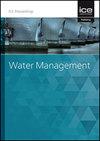非均质坡耕地土壤湿润锋点源扩展试验研究
IF 1.1
4区 工程技术
Q3 ENGINEERING, CIVIL
Proceedings of the Institution of Civil Engineers-Water Management
Pub Date : 2023-06-27
DOI:10.1680/jwama.21.00107
引用次数: 0
摘要
本研究旨在利用物理模型测量不同条件下的润湿锋推进(WFA)。湿润锋推进及其在土壤中的分布是滴灌过程中的重要参数之一。它受许多因素的影响,包括土地坡度、排放物排放和土壤质地。通过建立一个宽60 cm、高120 cm、长160 cm的物理模型,考察了这些因素的影响。试验采用2种非均质土壤、3种坡地(0、10和20%)、3种灌溉水(2、4和8 L/h)和定容灌溉水(24 L)。并将三层非均质土与三种均质土(重、中、轻质地)的结果进行了比较。结果表明:在坡地上,灌丛下游的湿化面积比灌丛上游的湿化面积大20 ~ 62%;随着坡度的增加,灌丛下湿润深度减小3 ~ 18%。当地表坡度从0 ~ 10%变化,再从10 ~ 20%变化时,在流量为2、4和8 L/h时,湿润锋的最大半径平均分别增大32%、44.8%和77.5%。本文章由计算机程序翻译,如有差异,请以英文原文为准。
Experimental study of the expansion of soil wetting fronts from a point source in heterogeneous sloping lands
This research intended to measure wetting front advancements (WFA) under various conditions using a physical model. Wetting front advance, along with its distribution in soils, is one of the important parameters in drip irrigation. It is influenced by many factors, including land slope, emitter discharge and soil texture. The effects of these factors were investigated by constructing a physical model with dimensions of 60 cm in width, 120 cm in height and 160 cm in length. The experiments were conducted using two heterogeneous soils, three land slopes (0, 10 and 20%), three emitter discharges (2, 4 and 8 L/h) and a constant volume of irrigation water (24 L). The results of the heterogeneous soils with three horizontal layers were also compared with those of three homogeneous soils (heavy, medium, and light textures). The results indicate that on sloping lands, the wetted area of the WFA downstream from the emitter was, on average, 20–62% greater than upstream from the emitter. With increases in land slope, the wetted depth under the emitter decreased by 3–18%. Also, when land slope changed from 0–10% and then again from 10–20%, the maximum radius of the wetting front increased, on average, by 32%, 44.8% and 77.5% for discharges of 2, 4 and 8 L/h, respectively.
求助全文
通过发布文献求助,成功后即可免费获取论文全文。
去求助
来源期刊
CiteScore
2.10
自引率
0.00%
发文量
28
审稿时长
6-12 weeks
期刊介绍:
Water Management publishes papers on all aspects of water treatment, water supply, river, wetland and catchment management, inland waterways and urban regeneration.
Topics covered: applied fluid dynamics and water (including supply, treatment and sewerage) and river engineering; together with the increasingly important fields of wetland and catchment management, groundwater and contaminated land, waterfront development and urban regeneration. The scope also covers hydroinformatics tools, risk and uncertainty methods, as well as environmental, social and economic issues relating to sustainable development.

 求助内容:
求助内容: 应助结果提醒方式:
应助结果提醒方式:


